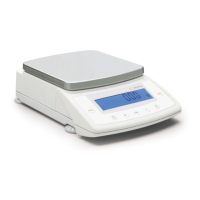Do you have a question about the Sartorius CPA224S and is the answer not in the manual?
Guidelines for safe operation and handling of the balance to prevent damage.
Safety recommendations concerning installation and connection of peripheral devices.
Recommendations for handling the balance during storage and shipping.
Steps for safely unpacking the equipment and checking for damage.
Choosing an optimal location, considering environmental influences.
Procedure for acclimatizing the balance to room temperature.
Information on seals for balances used in legal metrology.
Step-by-step guide for installing the CPA2P balance model.
Steps for installing the CPA2P-F model, including filter pan usage.
Instructions for positioning and securing the analytical draft shield.
Connecting the balance to AC power using the adapter.
Guidance on using appropriate power cords for different regions.
Safety precautions related to plug-in AC adapters.
Information regarding the universal AC adapter's specifications.
Notes on FCC regulations for radio frequency interference.
Steps for connecting external devices like printers or computers.
Recommended time for the balance to stabilize after power connection.
Specific considerations for using balances in legal metrology.
How to install an antitheft device to secure the balance.
Procedure for leveling balances with a capacity up to 10 kg.
Procedure for leveling balances with a capacity over 10 kg.
Explanation of the balance display and control buttons.
Description of the basic weighing function and its capabilities.
Guidelines for using the balance as a legal measuring instrument.
Specific advice for operating microbalances for accurate results.
Initial steps for preparing and powering on the balance.
Operations like switching the balance off or stand-by mode.
Specific instructions for filter weighing on CPA2P-F models.
Steps for setting up below-balance weighing on analytical balances.
Instructions for below-balance weighing on CPA2P microbalances.
Explanation of why calibration and adjustment are necessary.
Requirements for calibration in legal metrology applications.
Conditions and options for performing calibration and adjustment.
Specifics for external calibration on accuracy class II balances.
Step-by-step guide for internal calibration and adjustment.
Configuration options for the calibration and adjustment sequence.
Explanation of how the automatic isoCAL calibration works.
Restrictions on isoCAL for balances verified for legal metrology.
How to adapt the balance to individual requirements via setup menu.
Procedure for entering the balance's setup menu.
Instructions on how to print current balance parameter settings.
Configuring measurement environment parameters for records and display.
Details on characters for IDs, date/time, and display brightness levels.
Controls used for inputting IDs, time, date, and brightness.
Key assignments for starting, toggling, and ending application programs.
How application programs are used with legal measuring instruments.
Weighing components up to a defined total; storing and printing results.
Determining the number of parts by weighing a reference quantity.
Keys used for initiating piece weight determination and toggling.
How to set and store the reference sample quantity.
Automatic updating of reference sample for optimized counting accuracy.
Using a reference balance for higher precision in counting.
Obtaining weight readouts in percent relative to a reference weight.
How to set and store the reference percentage value.
Determining weights of unstable samples by averaging operations.
Configuring the number of averaging operations and animal activity.
How to switch the display between two weight units using menu code 2.1.2.
Creating printouts with weights, values, and identification codes.
Default configurations for manual and automatic printouts.
Printing initialization values for active application programs.
Generating printouts compliant with ISO/GLP standards.
Configuring automatic weight value printing based on conditions.
Using menu codes to customize printout formats and content.
Parameters included in ISO/GLP printouts before and after weighing.
Menu codes for setting up ISO/GLP compliant records.
Using function keys to output ISO/GLP headers and reference data.
Connecting the balance to computers or peripherals via serial interface.
Default transmission rate, parity, stop bits, and handshake settings.
Steps before connecting, including checking pin assignments.
How non-verified digits are identified in printouts.
Structure and characters for data output with 16 characters.
Meaning of special codes (H, L, C) and error codes.
Structure of data output including ID code and 16-character string.
Defines the structure of control commands sent to the balance.
Details the meaning of specific command characters like K, L, M, N.
Matching balance and device parameters for error-free communication.
Explanation of hardware (CTS/DTR) and software (XON/XOFF) handshake.
How software handshake (XON/XOFF) controls data flow.
Configuring automatic printing of data at set intervals.
Contacting Sartorius for output speeds faster than 10 Hz.
Specifications for the 25-contact D-Submini female connector.
Details for the 25-pin D-Submini male connector.
Cautionary note regarding incorrect RS-232 cable pin assignments.
Pinout description for the interface connector.
Steps to prepare the CPA2P balance for safe transport.
Steps to prepare the CPA2P-F balance for safe transport.
Information on professional service and authorized repairs.
General guidelines for cleaning the balance and its parts.
Specific instructions for cleaning stainless steel components.
Guidance on disposing of packaging materials responsibly.
Proper disposal procedures for the balance and its batteries.
Detailed technical specifications for CPA2P and CPA2P-F models.
Accessories for data output and remote monitoring.
Optional battery packs for portable operation.
Protective cases for transporting the balance.
Software for transferring weighing data to a computer.
Accessory kit for density determination measurements.
Specialized weighing pan for antistatic applications.
Weights available for calibration, with DKD certificate option.
Guidance for optimizing balance use in quality management systems.
Power adapters for different weighing capacities and voltages.
Accessory chamber for analytical draft shields.
Covers for draft shields and cables for PC connection.
Switches and adapters for remote control of balance functions.
Accessories for below-balance weighing and sample containment.
Protective covers for balance display units and control units.
Information on EU directives for weighing instruments in legal metrology.
Services provided for installation, verification, and inspection.
Information on the validity and renewal of verification in European countries.
Description of identification plates and markings on balance models.
| Maximum Capacity | 220 g |
|---|---|
| Readability | 0.1 mg |
| Repeatability | 0.1 mg |
| Linearity | ± 0.2 mg |
| Display | LCD |
| Interface | RS232 |
| Operating Temperature | 15 °C to 30 °C |
| Pan Size | 90 mm |
| Power Supply | 50/60 Hz |











